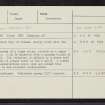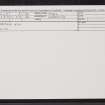Scheduled Maintenance
Please be advised that this website will undergo scheduled maintenance on the following dates: •
Tuesday 3rd December 11:00-15:00
During these times, some services may be temporarily unavailable. We apologise for any inconvenience this may cause.
Labothie Hill
Cairn (Early Bronze Age)
Site Name Labothie Hill
Classification Cairn (Early Bronze Age)
Alternative Name(s) Bractullo Muir
Canmore ID 33649
Site Number NO44SE 8
NGR NO 47812 41893
Datum OSGB36 - NGR
Permalink http://canmore.org.uk/site/33649
- Council Angus
- Parish Inverarity
- Former Region Tayside
- Former District Angus
- Former County Angus
NO44SE 8.00 47812 41893
NO44SE 8.01 NO 4780 4188 Pillbox
For other nearby cairns, see NO44SE 9, NO44SE 22, NO44SE 27.
(NO 4780 4188) Cairn (NR) (Remains of)
OS 6" map, Forfarshire, 2nd ed., (1923)
A circular heap of stones, nearly level with the ground.
Name Book 1859.
NO 4780 4188. The remains of a large cairn, visible as a vague stony mound c. 30.0m in diameter with a maximum height of 1.0m on the S. Its perimeter is defined by a stone kerb which survives at groundlevel in the N and E. A number of wartime installations exist upon and around this cairn, which is now scarcely recognisable.
Visited by OS (J L D) 12 August 1958.
Previous field report confirmed.
Visited by OS (E G C) 5 September 1967.
This monument comprises the remains of a burial cairn of prehistoric date situated in moorland at around 215m OD. It comprises a sub-circular heap of stones some 35-40m in maximum diameter with a maximum surviving height of approximately 1m. Indications of a kerb of large boulders are visible in the N and E. Despite disturbance to the surface by small rectangular turf structures, possibly the remains of pre-modern bothies, and a wartime pillbox, it is to be expected that evidence for Bronze Age burial and ritual practices will survive in and below the mound.
Information from Historic Scotland, scheduling document dated 6 March 1997.










